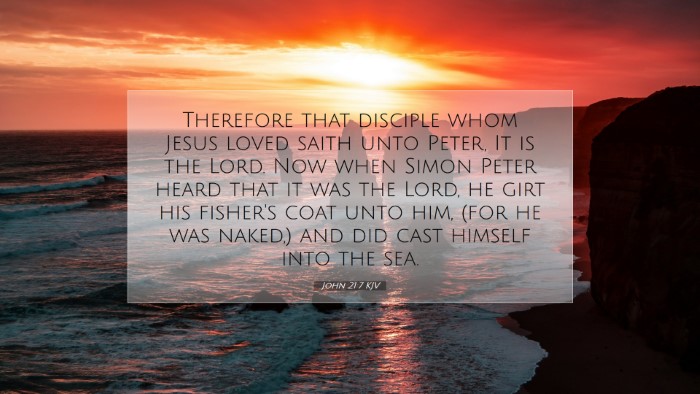Old Testament
Genesis Exodus Leviticus Numbers Deuteronomy Joshua Judges Ruth 1 Samuel 2 Samuel 1 Kings 2 Kings 1 Chronicles 2 Chronicles Ezra Nehemiah Esther Job Psalms Proverbs Ecclesiastes Song of Solomon Isaiah Jeremiah Lamentations Ezekiel Daniel Hosea Joel Amos Obadiah Jonah Micah Nahum Habakkuk Zephaniah Haggai Zechariah MalachiJohn 21:7
John 21:7 KJV
Therefore that disciple whom Jesus loved saith unto Peter, It is the Lord. Now when Simon Peter heard that it was the Lord, he girt his fisher's coat unto him, (for he was naked,) and did cast himself into the sea.
John 21:7 Bible Commentary
Commentary on John 21:7
John 21:7 states, "Therefore that disciple whom Jesus loved said to Peter, 'It is the Lord!' Now when Simon Peter heard that it was the Lord, he put on his outer garment (for he had removed it) and plunged into the sea." This passage holds profound significance as it not only captures the moment of recognition of Jesus' presence but also reveals the character and impulsiveness of Peter, reflective of the human condition in response to divine encounters.
1. Contextual Analysis
This verse occurs during a post-resurrection appearance of Jesus to His disciples, as they were fishing near the Sea of Tiberias. The chapter reflects themes of restoration and commission, specifically for Peter following his denial of Christ. It serves as a crucial turning point where the disciples are reaffirmed in their roles as followers and leaders in the early Church.
2. The Role of the Beloved Disciple
Matthew Henry notes that the beloved disciple, traditionally identified as John, plays a critical role in this narrative. His declaration, "It is the Lord!", acts as a catalyst for Peter’s immediate action. Henry emphasizes that this identification affirms not only personal recognition but also the revelation of Jesus' ongoing relationship with the disciples. The beloved disciple’s keen insight exemplifies a deeper spiritual awareness and recognition of Christ’s presence in their midst.
3. Peter's Response
Upon hearing the beloved disciple's proclamation, Peter's reaction is swift and instinctual. Albert Barnes comments on the impulsive nature of Peter, which often led to both commendation and contradiction. His act of putting on his outer garment, even as he prepares to leap into the water, speaks to his desire to present himself appropriately before the Lord. This action reflects a mix of eagerness and perhaps a sense of humility, as he approaches Jesus in a prepared manner despite being in a state of urgency.
4. Theological Implications
In exploring the theological implications of this passage, Adam Clarke suggests that Peter's leap into the sea symbolizes a profound yearning for communion with Christ. It underscores a significant aspect of discipleship—the recognition and prioritization of Christ’s presence over all else. Peter’s actions can be seen as a metaphor for the believer’s call to approach Christ passionately and without hesitation, emphasizing that such a response is integral to the Christian faith.
4.1 Restoration and Reconciliation
This passage serves as a poignant reminder of God’s willingness to restore and reconcile. Peter, who had previously denied Jesus three times, is now thrust back into the relationship he craves. The impulsive nature of his leap illustrates a profound repentance and desire to reconnect with the Lord, emphasizing the boundless grace offered to those who falter.
5. Practical Applications
For pastors and theologians, this verse presents several practical applications:
- Encouragement for the Erring: It shows that regardless of one's failures, there is always an opportunity for restoration in Christ.
- The Importance of Recognition: The ability to recognize Christ in daily situations is central to a vibrant faith.
- Urgency in Following Christ: Believers are called to respond actively and decisively to God’s call, showcasing a willingness to leave behind distractions.
6. Conclusion
In summary, John 21:7 serves as a pivotal moment that encapsulates themes of recognition, response, and restoration in the life of a disciple. Through insights drawn from Matthew Henry, Albert Barnes, and Adam Clarke, we find a compelling narrative that emphasizes the significance of knowing Christ and responding with heartfelt urgency. As believers reflect on this passage, they are reminded that the path to restoration is through recognizing the Lord’s presence and responding with eager hearts.


